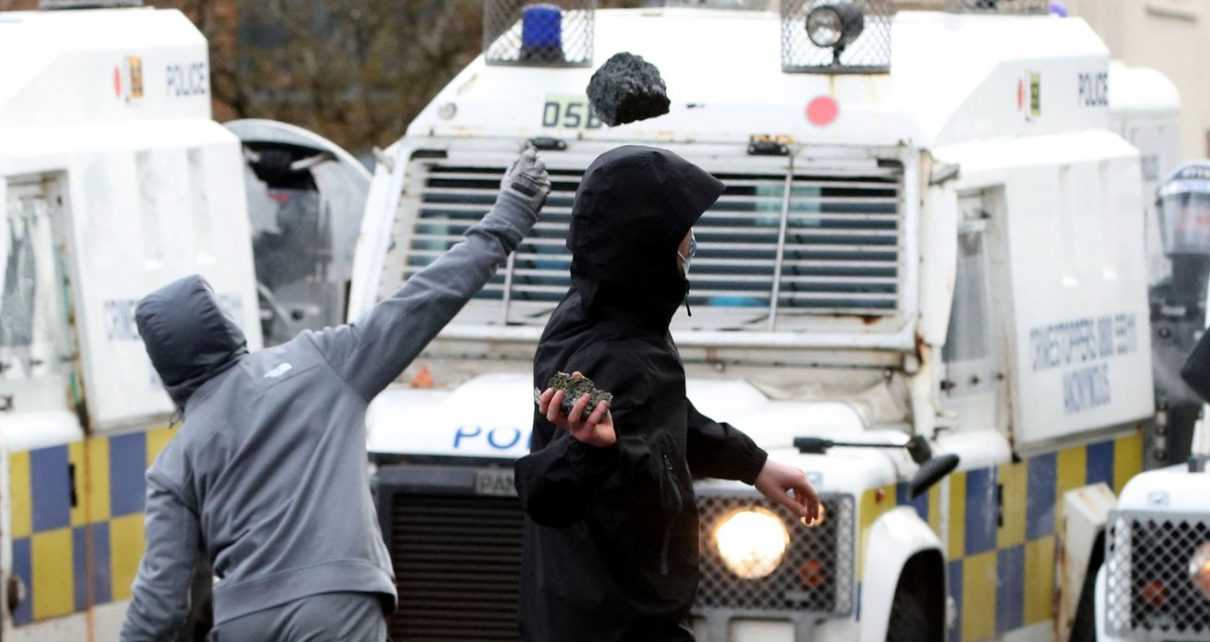
Brexit and suspicions of favoritism are fueling a conflict that has been simmering for years despite peace accords.
Rioting in Northern Ireland continued on Friday night, with demonstrators using gas bombs against the police and setting a car on fire in the capital of Belfast.
The night of violence marked the eighth straight day of demonstrations and unrest in five towns and cities across Northern Ireland — a trend that has some experts worried about the possibility that the region could be seeing a sustained resurgence of sectarian violence. A 1998 peace agreement ended 30 years of such conflict, known as “the Troubles,” but unrest and violence has flared up from time to time ever since.
Over the past week, a double-decker bus has been hijacked and set on fire; masked youths have hurled homemade gas bombs at police; rival gangs have thrown bricks and fireworks at each other. So far there have been no deaths reported, but at least 74 police officers have been injured, and observers say that the period of turbulence marks the worst sectarian violence Northern Ireland has seen in eight years.
Most of the rioters are young people — some as young as 12, the Police Service of Northern Ireland told CNN. The violence has been concentrated in “unionist” communities, but conflict has also taken place in areas dividing unionist communities from “nationalist” neighborhoods. During the Troubles, unionists were largely Protestant and identified with loyalty to the United Kingdom, and nationalists were mostly Catholics, identified as Irish, and sought a united Ireland.
While conflict between the groups formally ended with the Good Friday Agreement in 1998, tensions and violence that hark back to the Troubles still resurface, and are often tied to concerns that one group holds undue influence or power over national affairs. The current set of clashes has become high-profile enough that the Biden administration released a brief statement expressing concern about rising violence.
Experts say that there is not one clear explanation for the recent clashes, but that there are a few different factors — which may be feeding off of each other. Brexit, and the sense in unionist communities that London is neglecting Northern Ireland by the terms of the agreement are one factor. Another issue is a recent decision by authorities to avoid prosecuting nationalist politicians for flouting Covid-19 protocols.
What is clear is that political observers see violence escalating at a worrying pace. “I think it’s very serious. It’s easy to see how things can escalate and hard to see how things can calm down,” Katy Hayward, a professor of political sociology at Queen’s University, Belfast, told the New York Times.
There are multiple factors driving the unrest in Northern Ireland
Conflict and violence between unionists and nationalists dates back decades. But the most recent spate of violence seems to be, at least in part, a response to a specific flashpoint in the relationship between the two communities.
A great deal of the initial violence came after state prosecutors decided last month they would not charge the leaders of nationalist party Sinn Fein for breaking Covid-19 regulations in June by attending the funeral for Bobby Storey. Storey was a former top member of the Irish Republican Army, the paramilitary group that waged a violent campaign against the British and for a reunified Ireland during the Troubles.
Many unionists perceived the decision to not prosecute the members of the party as a sign of political favoritism, given that unionists were told to cancel their traditional Twelfth of July parades last summer, and the loaded symbolism surrounding the funeral. The decision sparked outrage and protests.
“This is happening because of the PSNI [Police Service of Northern Ireland] and the judiciary system’s appeasement of republicans,” said Ian Edwards, a resident of the Shankill Road, a Protestant community, referring to the nationalists who favor a united Ireland.
Experts say another major factor fueling the anger and protests is the way that many in Northern Ireland feel betrayed by the terms of Brexit — the United Kingdom’s departure from the European Union — which was completed at the beginning of this year. In this scenario, unionists feel blindsided by the British government, which they believe has left them in a lurch, as the New York Times reports:
Under an agreement in a protocol struck by [British Prime Minister Boris] Johnson, Northern Ireland was given a special economic status that leaves it straddling the United Kingdom and the European Union trade systems.
However, it also imposes some new checks, particularly on goods flowing from mainland Britain to Northern Ireland — something that is anathema to unionists who want equal treatment with the rest of the United Kingdom.
Despite the deal he signed up to, Mr. Johnson promised that there would be no new “border in the Irish Sea,” and, glossing over the looming difficulties, his government did little to prepare opinion in Northern Ireland for the changes.
Yet on Jan. 1, when the post-Brexit trade rules came into force, businesses faced new paperwork and some British companies stopped moving goods to Northern Ireland, causing some shortages on supermarket shelves. Amid rising tensions, checks on goods were halted temporarily after threats were made against customs staff.
In other words, Northern Ireland unionists feel they’ve been misled about the terms of Brexit and the economic impact it would have on them.
Another complicating factor is that the period around the Easter holiday often features “increased communal conflict,” Politico notes, because of Irish Republican Army commemorations among nationalists in Northern Ireland on the one side and unionist parades on the other.
Further complications may be coming from criminal groups who might be trying to add to the chaos and exploit tensions over Covid-19 restrictions in order to cause problems for law enforcement.
There’s a complex array of factors that could explain what’s contributing to the current chaos — and given that swirl, it could evolve further in the future.





